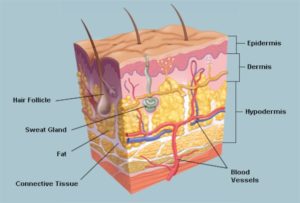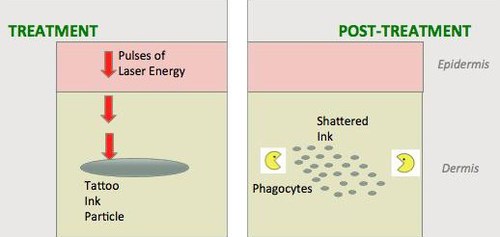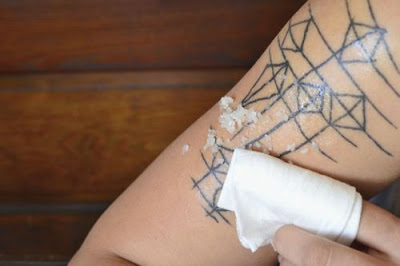Do you have unwanted tattoos? Have you ever thought about having your tattoo removed, but thought that tattoo removal was impossible? Well, it’s not! BUT, please remember, IT IS MUCH EASIER TO GET A TATTOO THAN IT IS TO REMOVE A TATTOO! Alternatives in Health Care Detox Therapy Spa is the only place in Arizona that is using plasma technology to remove unwanted tattoos. The plasma arc by Areton Ltd is very different than a laser. It does not leave blisters and it is not color sensitive. It can be used with any skin tone, no matter how light or dark you are. A warning is warranted here, if you are prone to keloid scarring, it is wise to avoid getting or removing a tattoo.
I’d like to give you an informative description of how lasers work, then I will tell you the difference between our machine and technique and what is currently available on the market. I want to keep this lesson as simple as possible so everyone can understand what is going to happen to your tattoo and your skin, but I feel that it is necessary to have a decent idea of what is actually going to happen BEFORE you make a decision to have your tattoo removed.

Let’s give you a short lesson on the layers of the skin. As you can see in this picture, there are basically 3 layers of skin. The epidermis is the top layer of dead skin cells. This skin is what you see and it is on its way to flaking off and letting newer more supple skin come to the surface. If you scratch the surface of your skin and you don’t bleed, you stayed in the epidermis. There are nerve endings there but no live cells, so you can feel your touch, but you haven’t damaged anything live.
This picture also shows the dermis and the hypodermis along with other things that are under your skins surface.
For this lesson we aren’t going to talk about hair follicles and all of the other things that are listed on the left side and the bottom of the picture. We are going to concentrate on the 3 layers that are outlined on the right side of the picture. There is one thing that I want you to look closely at; as it is not highlighted in this picture. You can clearly see the lines showing the epidermis, the dermis and the hypodermis on the outside of the skin in the picture. What I’d like you to notice is a wavy purple line that runs under the epidermis but above the dermis. Do you see it? This is the upper dermis or the papillary dermis. It is a thin layer of connective tissue that connects the epidermis and the dermis. This is the place where live skin meets older dying or dead skin.
Okay, now that you can see the inside of the skin, I’d like to let you know that what gives your skin its color. Melanin is produced in the epidermis. Everyone has cells that produce melanin, they are called melanocytes. People with darker skin have more melanocytes than people with lighter skin do. Remember this fact when we get to the part of the lesson on how lasers work.
Onto the next phase of your tattoo and your skin; when you get a tattoo, the artist’s needle pierces through the epidermis, the upper dermis and lands the ink deep into the dermis. Remember the dermis is where your skin grows. The planted ink is buried deep in the dermis and becomes a mostly permanent part of your skin. I say mostly permanent because over time as your skin grows new layers, the ink will slowly rise to the surface of your skin. Not all of it will, but some of it does. This is what causes fading and blurring of a tattoo. When you first get your tattoo, the color is extremely bright, right? As it heals, it loses a little bit of color as the ink makes its way to the surface. Therefore your newly healed tattoo doesn’t look as bright as it did as soon as the ink was pushed into your skin. The skin is always replenishing itself, so you will always have cells that work their way up to the surface of your skin. As minute particles of ink rise to the surface, you get a little bit of fading.
When you are trying to have a tattoo removed, you want to have as many ink particles fade as possible. Here is the difference between lasers and electrical plasma arcing. In order for you to understand and make an informed decision on how you would like to have your tattoo removed I feel like education on both types of techniques should be discussed. Instead of getting really technical here, I am going to add a link about how lasers work. If you want technical info feel free to click here http://voltaicplasma.com/laser-tattoo-removal/
The short version goes like this. A laser is a concentrated beam of light that can penetrate through the epidermis, the upper dermis and the dermis. (It could also go deeper if the tech wanted it to.) There are different wave lengths that make each laser’s purpose different. For this discussion, let’s use a very simple analogy about tattoo ink. Let’s just say that certain laser wavelengths see and attack certain tattoo ink colors. If you don’t have a laser with multiple wavelengths the laser will only be able to break up a certain color. Lasers are color sensitive. Many colors are very difficult for lasers to remove. The same principle applies here as with laser hair removal. Laser hair removal does not do well with blondes or redheads, as their hair doesn’t have enough pigment for the laser to see, so it usually doesn’t work very well for fair haired people. Light colors such as pastels, pinks, yellows, purples and light blues don’t have enough pigment for the laser to see. Green is an extremely difficult color for lasers to remove!

The way that lasers work is pretty simple to explain when you are not trying to get technical. The laser beam is placed over the tattoo (traced) and the light penetrates the top 2 layers of skin producing a deep controlled burn. Once the light wave hits the right color ink, it will break up the ink particles and shatter and scatter them into the dermis. Then the immune system kicks in and certain white blood cells (phagocytes) attack the ink particles (it views them as enemies) and they are absorbed into your bloodstream and taken away.

Remember this is an overly simplified explanation of what happens during this process. If the particles aren’t grabbed they stay where they are. Shattered and broken, but still visible. Each time you have another laser treatment the same process will happen. A very important bit of info that needs to be noted here, is, that the laser’s light causes burns to the whole area that it touches, not just the ink pigments. So dermal damage can and usually is caused no matter how skilled the technician is! Scarring, blistering and ghosting (white images of where the tattoo ink used to be) are all very common in laser tattoo removal. Blistering and bleeding is a very common side effect of laser tattoo removal. Chances of getting infections due to opened skin can be quite high if proper aftercare is not heeded.
Plasma tattoo removal
In this section, I will explain how we remove tattoos at Alternatives in Health Care Detox Therapy Spa. Again, it will be simplified. If you would like more detailed info, please click here. http://voltaicplasma.com/tattoo-removal-with-osmosis/ The plasma arc is very different than a laser. The results for tattoo removal are consistent and usually produce faster, better results than lasers do. There are usually less treatments needed to accomplish the same degree of fading using the plasma arc versus a laser. There is less chance of ghosting and scarring as the procedure does not go into the dermis. Please remember, it is easier to get a tattoo than to get rid of one. They were put there in hopes of being permanent. At this point in time, seamless tattoo removal is very difficult to achieve. Fading an unwanted tattoo and replacing it with a new one is usually what people are planning on.
We believe under the right circumstances, using the plasma arc can achieve a more seamless tattoo removal. Although no one with any current kind of equipment can guarantee a seamless removal, the two step process that we use actually draws the pigments to the surface of the skin and it falls off with the scab, therefore removing the ink, not scattering and shattering it.

Okay, here’s how it works. The plasma arc isn’t a light beam. It is actually and electrical arc with very specific frequencies. Your first visit will include a consultation and a patch test. This allows us to see how your skin is going to react to the procedure and it gives us a better platform to give you a better idea of how many sessions it will take to accomplish your goal. The tattooed area will be covered with a topical anesthetic allowing the technician to work smoothly without the client being uncomfortable. The arc is held above the skin and causes a mild, topical, controlled burn. This process opens up the epidermis (not the dermis) and makes an exit point for the tattoo ink. Once the portion of the tattoo that is going to be treated in a single session has been (traced) over, the epidermis is open and ready for the second step. A sterile saline paste will be applied (creating osmosis, which is a drawing effect) to the treated area and covered for a determined amount of time. Once the desired time has been reached, the covering and the saline paste will be removed and the area will be thoroughly cleaned. A recovery cream will be applied and the aftercare kit that you have been given will go home with you.

Since we are NOT going down to the dermal layer, (we are opening up the top layer and drawing the ink upward) instead of going down to live skin, the chances of dermal damage is slim if done properly. The goal to this procedure is to open up the epidermal layer, use the process of osmosis to draw the tattoo ink up to the upper dermis, let it heal and then the ink will not be in the dermal layer any more. It will be in the upper dermis, which will become the new epidermis. Once that treatment has healed, the same process will be applied again. Since the arc isn’t light based, it doesn’t have the same limitations as a laser does. The plasma arc is basically “color blind”, instead of “color sensitive”, so it doesn’t matter what colors your tattoos are. The plasma arc treats all colors equally.
Another important factor about the plasma arc working on the epidermal layer instead of the dermis is there hasn’t been a reported case of hypo-pigmentation (the loss of melanin, that causes skin tone), therefore making this procedure safe for dark skinned people also. Many times lasers do cause hypo-pigmentation no matter what your skin tone is.
Just like lasers and when you first got your tattoo AFTERCARE is extremely important. You will have a shallow open wound, just like you did when you got your tatt. If you don’t follow the aftercare instructions you can get an infection and that could leave a scar. If you practice good aftercare the chances of having any issues after your treatment are pretty small. There will be no blistering, no bleeding and may feel like a mild sunburn for a few hours.
It is essential that you stay out of the sun and follow the rest of the aftercare treatment plan that your technician will give you before you leave.
For more info on aftercare (click here) contraindications (click here) prerequisites (click here) healing procedure (click here)
Contact Us Today!
